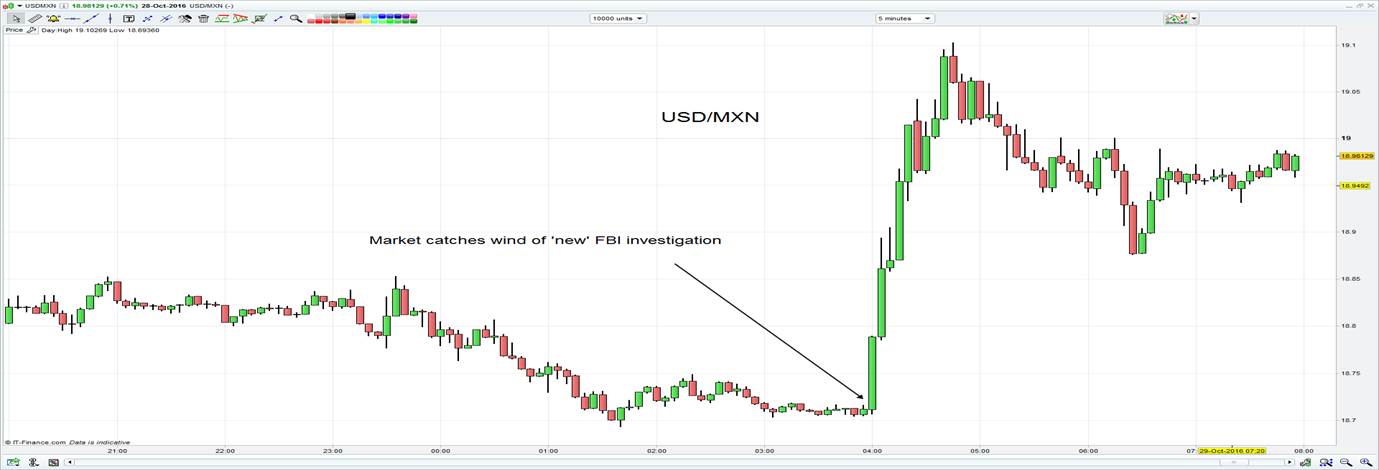The market gave us a reasonable idea about how it plans to react to a Trump victory, with politics dominating Friday's US trading session. The three words ‘FBI’, ‘investigation’ and ‘email’ really send the fear of dread into any loyal Clinton supporter, especially 11 days out from the election. It now seems that the FBI has actually known about the information and actually sat on it for weeks (Source: Washington Post), so naturally the Clinton camp are angry, as they see this to be a highly politicised move.
You would certainly hate to be the guy who has to scour the 650,000 emails on Anthony Weiner’s laptop! A nice job for the new guy.
Either way, the gap between Clinton and Trump has closed somewhat in various probability models, with a Sunday poll conducted by ABC/Washington Post saw Clinton’s prior 12 point lead reduced to just 1 percentage point (46% to Clinton/45% Trump).
The interesting dynamic here is that despite a strong headline US Q3 GDP report of 2.9% the interest rate market couldn’t really care less and the increased chance of Trump in the White House has actually seen the chance of a December rate hike fall to 70%. Keep in mind that if we scratch under the surface of the GDP report, we can see domestic demand (GDP ex-inventory and trade) growing a slower pace from Q2 at 1.4%.
So politics has once again shown that it trumps any economic data points and the fact the S&P 500 fell 1% over the ensuing hour (from when the FBI news was released), while USD/MXN spiked 2.1% (see attached chart) and healthcare was sold aggressively painted a clear picture.
If the market saw the FBI news as a Trump positive, but stopped short at feeling it was a genuine game-changer, then it really shows what will happen if Trump gets into power. There will be carnage in financial markets and the underlying concern remains around who can influence the Federal Reserve (Fed) and clearly market participants’ would need to fully understand the relationship between Trump and the Fed before they started to increasing risk to portfolios.
Politics aside, (and I haven’t even spoken about Bank of England governor Mark Carney potentially revealing his departure at this week’s Quarterly Inflation Report), we expect Asian markets to open either flat to lower. The ASX 200 should open in line with Fridays close, however the bears seem to be in control and as we saw on Friday the sellers jumped on the initial strength on open.
With the event risk due this week (China manufacturing/service sector data, numerous central bank meetings and US payrolls), amid concerns of massive volatility should Trump actually get elected (where’s the next bad news story going to come from?), its seems unlikely money managers are going to put too much money to work this week.
The nine basis point move higher in the Australian bond market last week is another key factor pushing the Australian equity market lower. If we can now get a 2.37% yield-to-maturity in the bond market, on a relative basis, the income in the form of company dividends becomes less compelling. We may well see buying in developed market fixed income this week (on risk aversion), but I wouldn’t expect any fall in yields to suddenly support the ASX 200.
Let’s also see what the RBA says tomorrow, but incredibly, six economists (including St George and CBA) are calling for a cut tomorrow, which can only be described as a huge contrarian call given the 6% probability priced into the interest rate markets. I can’t see it happening myself, but a cut tomorrow would see the AUD chopped up!
Diving deeper into commodity moves and while iron ore, steel and coking coal all carved out nice rallies on Friday, oil is over 2% weaker from Fridays ASX 200 close. The weekend OPEC meeting in Vienna has failed to show any cohesion between the OPEC members and there is no meat on the bone around the allocation of supply cuts for traders to really feel enthused. The crude futures open (at 09:00 aedt) may see the barrel fall even further given the lack of weekend news.

